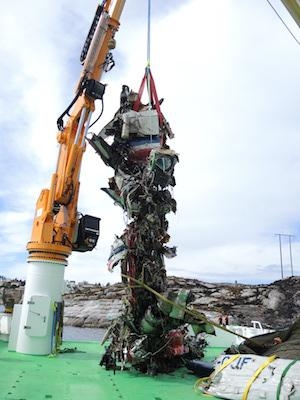Thirteen People Fatally Injured After Main Rotor Separation
Norway's Accident Investigation Board (AIBN) has released its final report from an accident which occurred on April 29, 2016 in which the main rotor separated from an EC225 helicopter with 13 people on board. All 13 were fatally injured when the aircraft impacted terrain on a small island near Turøy, northwest of Bergen.

According to the AIBN, the accident was a result of a fatigue fracture in a second stage planet gear in the epicyclic module of the main rotor gearbox. Cracks initiated from a micro-pit at the surface and developed subsurface to a catastrophic failure without being detected.
There are no connections between the crew handling and the accident. The AIBN has also excluded material unconformity and mechanical failure, as well as maintenance actions by the helicopter operator.
The investigation has shown that the combination of material properties, surface treatment, design, operational loading environment and debris gave rise to a failure mode which was not previously anticipated or assessed.
In a statement, EASA said that while the final report contains a number of opinions and hypotheses, in relation to the actions taken after the G-REDL accident and Return To Service (RTS), it is important to consider these in relation to what was known at the time.
The investigation on the G-REDL accident did not establish the root cause of the gear fatigue failure because several parts were not recovered. However, there was evidence of spalling occurring before the accident, including the detection of a gear particle by the maintenance organisation. This led to the decisions allowing increased detection of particles by recurrent maintenance.
The decisions taken by EASA after the G-REDL accident were based on the knowledge available at the time, and the actions put in place were justified and commonly agreed. The AIBN report now identifies micro pitting as initiating the crack that, with limited spalling, led to the gear failure in the case of LN-OJF. This had not been identified with respect to the G-REDL accident investigation or analysis.
EASA took the following actions following the accident and subsequent Return to Service (RTS) authorization for the aircrafts;
The RTS consisted of a number of mandatory airworthiness actions meeting the safety objectives as defined in Annex 1 (Part 21) of Commission Regulation (EU) No 748/2012.
The RTS was a first step in a sequence of actions that were foreseen in the associated Continuing Airworthiness Review Item (CARI) having the objective to consolidate and develop further safety improvements for the mid- and longer term. This means that the initial actions which were suitable in the short to medium term would be replaced by less maintenance intensive solutions.
From the AIBN report, EASA understands that the investigation did not reveal any facts or evidence available at the time that would invalidate the basis for the RTS.
Finally, EASA notes that the design, certification and continued airworthiness aspects of the Main Gear Box have been the main focus of this investigation. While EASA concurs with the AIBN’s final report regarding the most likely fracture mechanism, all the possible contributing factors to the failure initiation should still be considered relevant, even if the likelihood is considered remote or circumstantial by the AIBN. EASA will continue to take actions to address all such possible risks where considered necessary.
EASA sait it will continue developing our safety plan with improvements stemming from this report.
(Image from AIBN report)
 Unfortunate... ANN/SportPlane Resource Guide Adds To Cautionary Advisories
Unfortunate... ANN/SportPlane Resource Guide Adds To Cautionary Advisories ANN FAQ: Turn On Post Notifications
ANN FAQ: Turn On Post Notifications ANN's Daily Aero-Term (04.29.24): Visual Approach Slope Indicator (VASI)
ANN's Daily Aero-Term (04.29.24): Visual Approach Slope Indicator (VASI) ANN's Daily Aero-Term (04.28.24): Airport Marking Aids
ANN's Daily Aero-Term (04.28.24): Airport Marking Aids ANN's Daily Aero-Linx (04.28.24)
ANN's Daily Aero-Linx (04.28.24)



